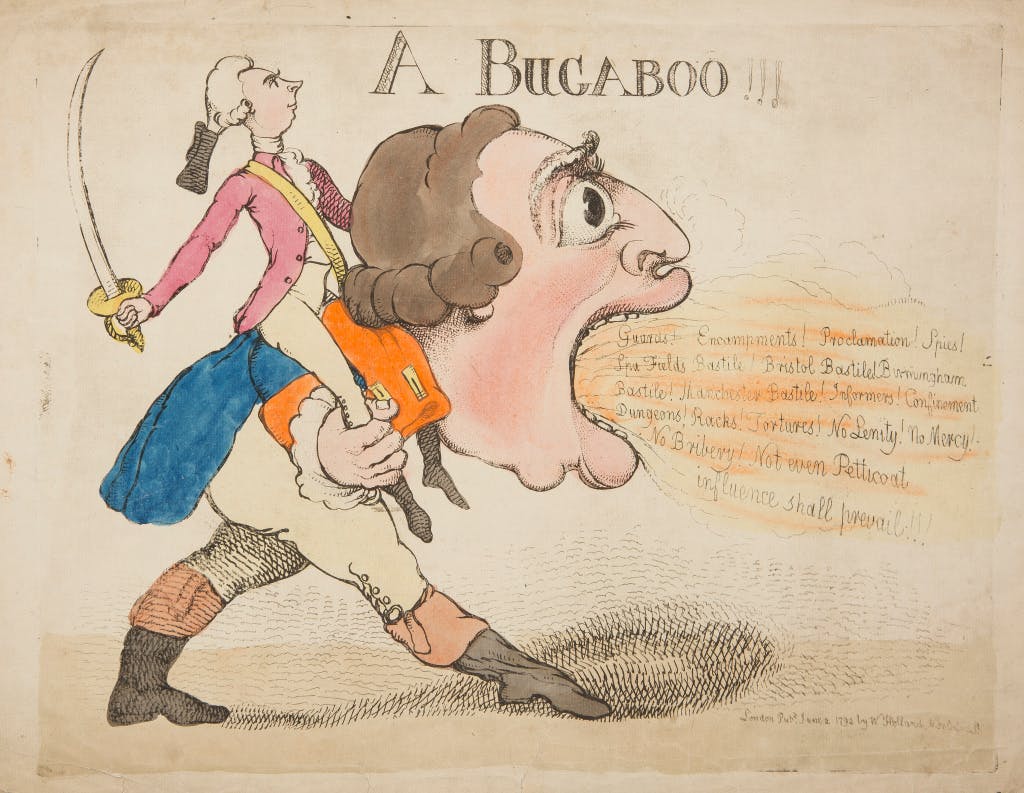A closer look: "A Bugaboo!", a political cartoon by Richard Newton from 1792
Date: 08 November 2016
Author:
Polly Putnam
No, I have no hankerings after posh prams. This month, I’m liking a political cartoon by Richard Newton. Of all the artists represented in our collection of satires depicting King George III, Newton is my favourite. He was the angriest and the youngest of all of the known satirical artists.
A Bugaboo! is widely considered to be amongst his finest works because of the way he has managed to manipulate George III’s features. The prime-minister, William Pitt, rides George III, depicted as a bugaboo - a slang term referring at once to a buggy and something with the ability to scare little babies.
The Bugaboo bellows out “’Guards/ Encampments!’ ‘Proclamation!’ ‘Spies!’ ‘Spa Fields Bastile!’ ‘Bristol Bastile!’ ‘Birmingham Bastile!’ ‘Manchester Bastile!’ ‘Informers!’ ‘Confinement Dungeons!’ ‘Racks!’ ‘Tortures!’ ‘No Lenity!’ ‘No Mercy!’ ‘No Bribery!’ ‘Not even Petticoat influence shall prevail!!!’”
The towns of Bristol, Birmingham, Manchester, and Spa-Fields in Islington were notorious for their radicalism. Many were influenced by thinkers and writers such as Joseph Priestly and Thomas Paine who advocated for religious freedom, universal suffrage and most dangerously, in the case of Thomas Paine, republicanism.
Radical groups in these towns distributed cheap copies of Thomas Paine’s “The Rights of Man” which systematically rejects any form of monarchy or hereditary government. In just one year 50,000 copies of this republican document were published.
William Pitt’s government were terrified that Britain might replicate the horrors of the 1789 French Revolution and took steps to limit the spread of revolutionary ideas. In May 1792, George III issued, at the behest of the government, the “Royal Proclamation Against Seditious Writings and Meetings”.
Magistrates were told to actively seek out and prosecute writers and publishers of dissenting literature. The owners of pubs who allowed radical meetings were also liable for prosecution under the act. Richard Newton produced “Bugaboo” in response. In it he expresses his fear of a totalitarian state, with Bastille-like prisons erupting across the country filled with political dissenters.
It is unusually large- about twice as large as his usual format-as if to say that his anger was too great to be contained on a normal sheet of paper. George III’s face is made bulging and ridiculous measuring about 13 cms high. William Pitt is depicted as being especially effeminate (always a bad thing in eighteenth century Britain) and officious.
Newton was quite correct to be furious and fearful. 1792 marked the start of a series of increasingly draconian measures by the government limiting freedom of speech, and movement. In 1793, The Aliens Act, which forced all foreigners entering Britain to register themselves was introduced with the aim of catching spies and limiting immigration.
The most radical of these laws was the 1794 suspension of Habeas Corpus, meaning that anyone who wrote or drew anything that the government found contrary, could be imprisoned without trial. In just two years, over 100 people were imprisoned for writing and publishing radical works. Newton, then a mere boy of only 15 years old, drew this in full knowledge that he could face imprisonment for his actions.
I like this object because it reminds me that the freedoms I enjoy today such as the right to vote, own property and criticise the government have been hard won for me by others.
This is the first of our monthly “This month I’m liking…” blogs by the curators about their favourite items in the collections.
By Polly Putnam
Curator, Collections
More from our blog

18th-century satire: displaying political cartoons at Kew Palace
10 June 2019
In the early 18th century there was in Britain an amazing freedom of the press. More newspapers were being printed than ever before. Cartoons and caricatures could be cheaply produced and easily distributed, and this led to a golden age of political satire.

The King's 'Malady': George III's Mental Illness Explored
22 March 2024
George III had four prolonged periods of illness during his reign. Despite his achievements, he is perhaps most commonly referred to as ‘The Mad King’ – an unhelpful phrase that undermines the extent of his deeply traumatic ailments, and ignores his physical symptoms.

Kew the Music: George III and Queen Charlotte's Instruments
15 June 2017
The reign of George III and Queen Charlotte saw a flourishing of arts and culture in Britain. The country's prospering cultural scene was undoubtedly encouraged by the royal couple's personal love of the arts.

